

Josh Nevett
CarExpert's top five large SUV reviews of 2025
2 Days Ago
It's around $10,000 more than the old one, but the new Toyota LandCruiser 300 Series GXL has a new platform and a new powertrain.
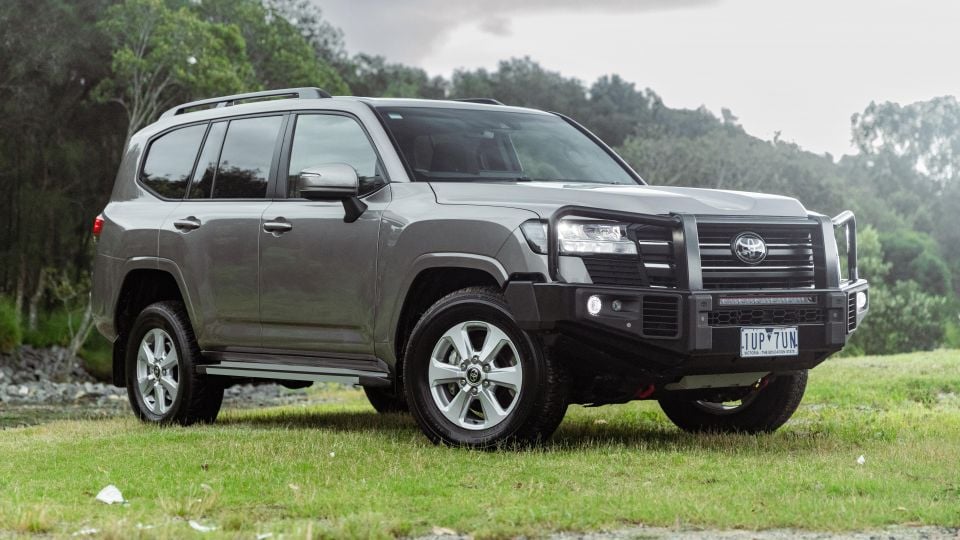
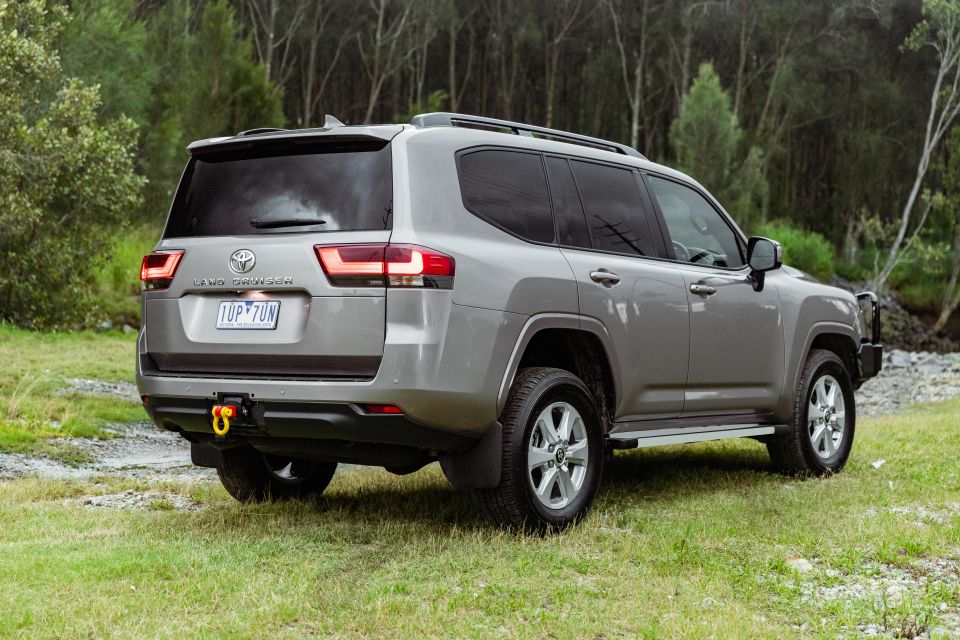

News Editor
New from
$89,990
excl. on-roads

News Editor
New from
$89,990
excl. on-roads


News Editor
New from
$89,990
excl. on-roads

News Editor
New from
$89,990
excl. on-roads
Quickly see how this car stacks up against its competition. Select any benchmark to see more details.
Where expert car reviews meet expert car buying – CarExpert gives you trusted advice, personalised service and real savings on your next new car.
It doesn’t happen often, but there’s an all-new Toyota LandCruiser in town.
For reasons beyond its control, however, Toyota isn’t able to flood Australian roads with them. COVID-19 affected many of the Japanese giant’s southeast Asian plants, leading to production pauses. Consequently, Toyota was only able to bring in an initial batch of 500 vehicles for use as dealer demonstrators.
Customer deliveries have subsequently commenced, albeit with the spectre of more production pauses and ever-growing waiting lists looming over one of the most hotly-anticipated vehicles in recent history.

With the 300 Series, the LandCruiser has moved to a new body-on-frame architecture (TNGA-F) and has received a new engine and transmission. It’s lighter, more powerful, and more fuel-efficient, while the model range has also grown to include a couple of new flagship models.
Our tester isn’t one of those flagships. Instead, it’s the bread-and-butter 2022 Toyota LandCruiser 300 Series GXL, with ours even fitted with a bull bar and inoffensive Dusty Bronze metallic paint so as to adeptly blend in on the roads of regional Australia.
LandCruiser aficionados will notice, however, the crisper body styling, with the belt line up-kick aft of the C-pillar, the leaner tail lights, and the bluffer front-end styling. It’s evolutionary overall, but the 300 Series looks more taut and less bulbous than the 14-year old 200 Series.
The GXL may be only one up from the base model but it cracks the $100,000 barrier, with a before on-roads price of $101,790. That’s more than $10,000 over the base GX, more than $10,000 over the 200 Series GXL, and works out to $109,599 drive-away based on a Sydney postcode.
That’s before you take into account the range of Toyota accessories fitted to our tester, which includes a bullbar with LED light bar, and recovery points (two up front, one down back). Our tester also included the aforementioned Dusty Bronze paint, costing $675.
There’s not much in the way of direct competition. The rival Nissan Patrol doesn’t offer a diesel, though you can get a flagship Ti-L with its 5.6-litre petrol V8 for $94,115 before on-roads.
There are two large, twin-turbo diesel six-powered SUVs from Land Rover at this price point: the 2023 Discovery D300 S at $105,975 before on-roads, and the Defender 110 D300 SE at $101,950 before on-roads. And just for context, there’s a glut of premium European SUVs at this price point, including entry-level versions of the Audi Q7 and BMW X5 plus mid-range versions of the Volkswagen Touareg.
Suffice it to say, the LandCruiser 300 Series isn’t cheap but, given the length of its waiting lists, that doesn’t seem to be a big deal to punters.
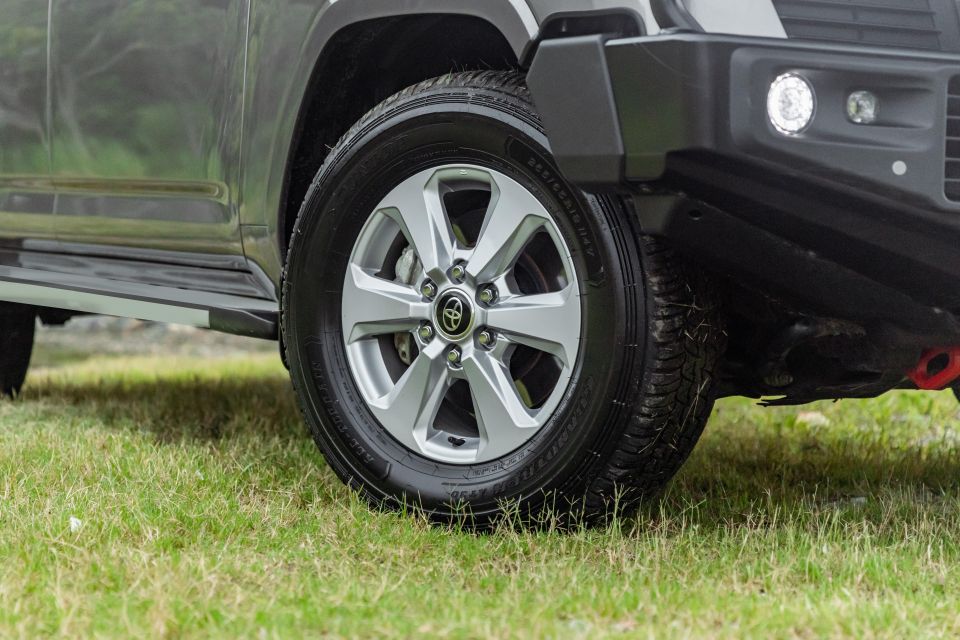
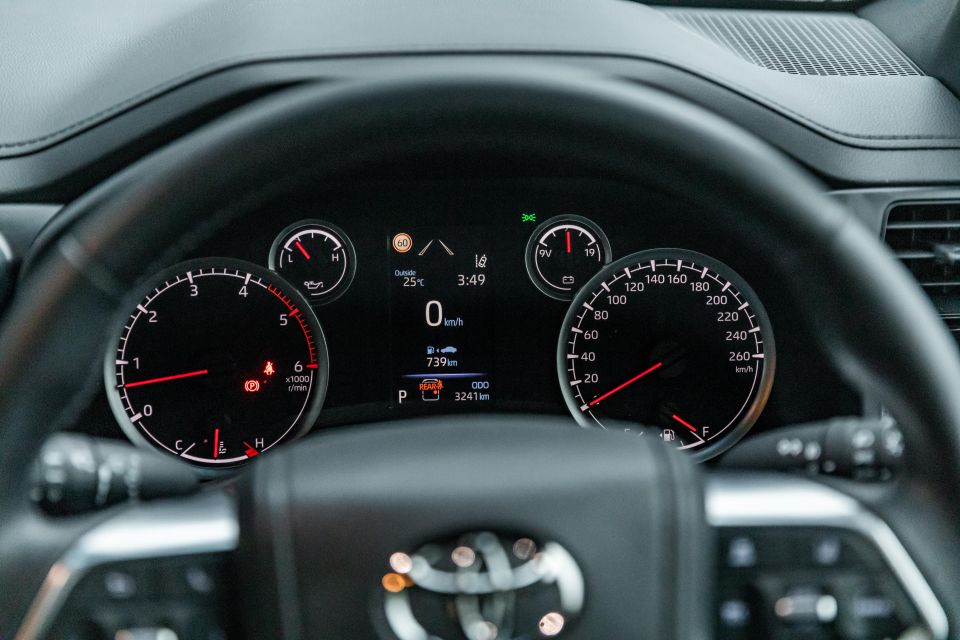
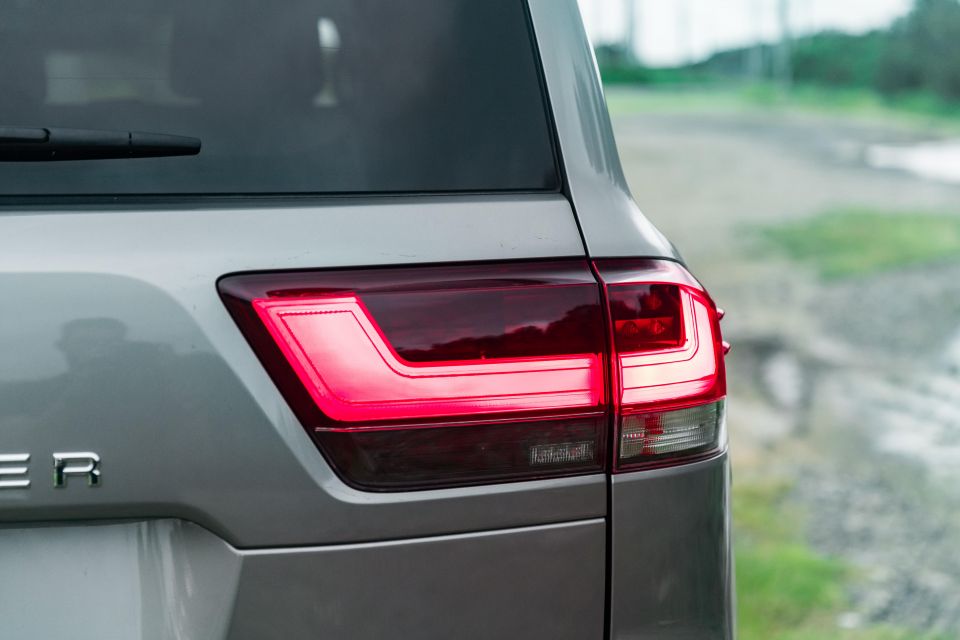
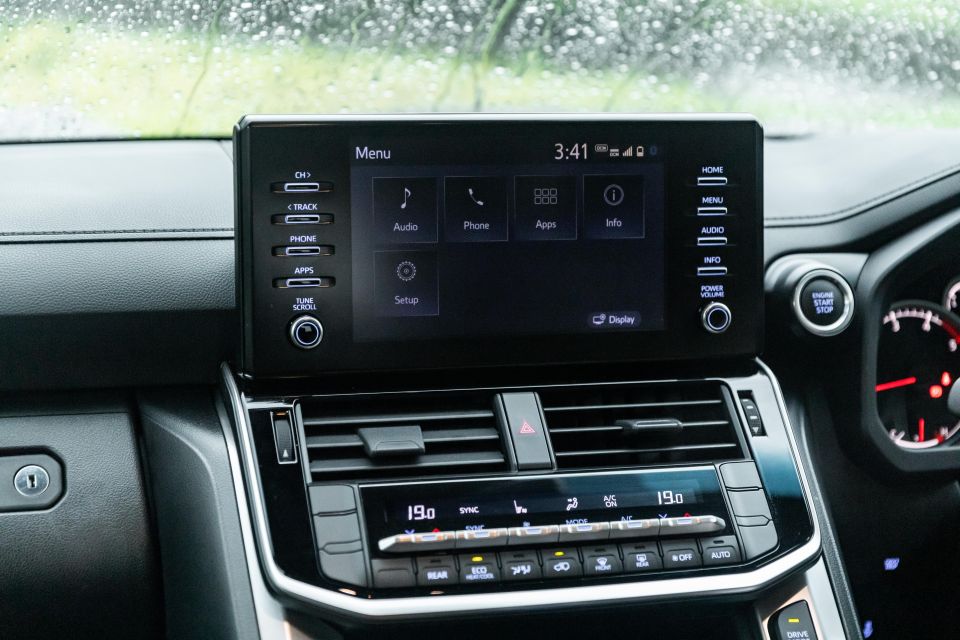
Buy your new car without the stress. It's fast, simple and completely free.

Great service from Travis and team, second time I have used this business would not hesitate to recommend them to anyone
Craig C.
Purchased a Ford Ranger in Sunshine Coast, QLD
CarExpert helped Craig save thousands on his Ford Ranger, now let us save you on your next new car.
Find a dealThe GXL is the most affordable seven-seater 300 Series, with the base GX a two-row-only affair. There’s no longer an eight-seat option available in the LandCruiser range.
LandCruiser 300 Series GXL highlights:
That’s over the equipment found in the base GX, which includes:
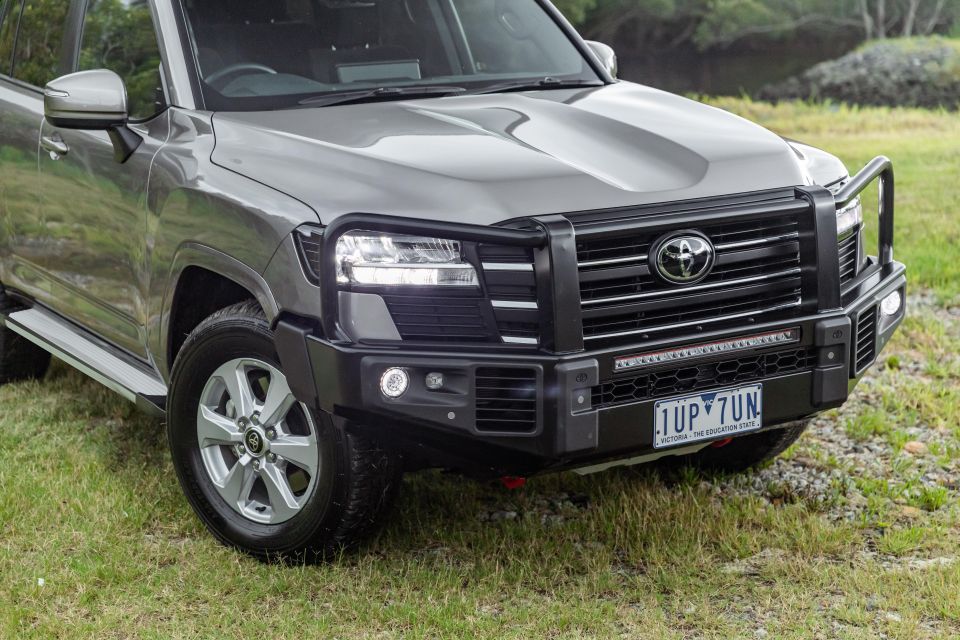
There are some frustrating omissions, particularly for an SUV at this price point. The lack of rain-sensing wipers is daft, while the absence of a surround-view camera in a truck this size is disappointing. There’s also no power tailgate.
Perhaps the most egregious omission is satellite navigation, not because Toyota’s system is class-leading but because a lot of 300 Series owners may live in regional areas where mobile reception is spotty and therefore Google/Apple Maps can’t always be relied upon.
Even a base Discovery packs a surround-view camera, power tailgate, panoramic sunroof, air suspension, rain-sensing wipers, leather upholstery and 14-way power front seats.
A Patrol Ti-L – though missing out on smartphone mirroring – has heated and ventilated front seats, a power tailgate, rear-seat entertainment screens, a sunroof, digital rear-view mirror, power tilt-and-telescoping steering column, 13-speaker Bose sound system, leather trim, a surround-view camera and a rear differential lock.
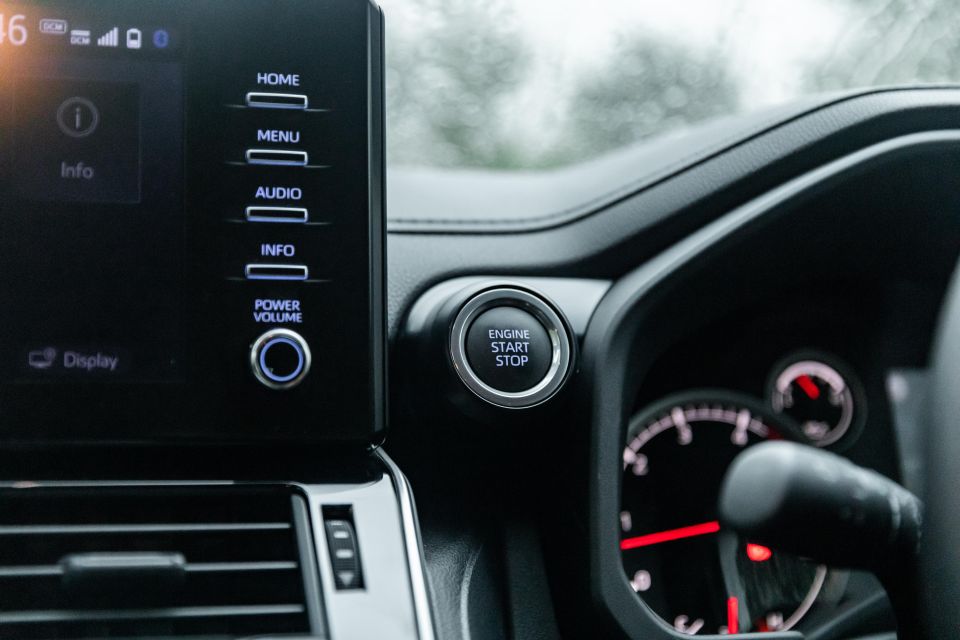
Stepping up to the LandCruiser VX yields a larger 12.3-inch touchscreen and 7.0-inch instrument cluster screen, as well as leatherette trim, rain-sensing wipers, heated and ventilated front seats, four-zone climate control, and a power-adjustable steering wheel.
But, you’ll pay handsomely for the privilege: the VX costs $12,200 more.
Compared to the 200 Series GXL, the new model has picked up blind-spot monitoring and rear cross-traffic alert, while its touchscreen measures 9.0 inches instead of a piddly 6.1.
But it’s also lost its eighth seat and its split tailgate, while the rest of the equipment list looks much the same.
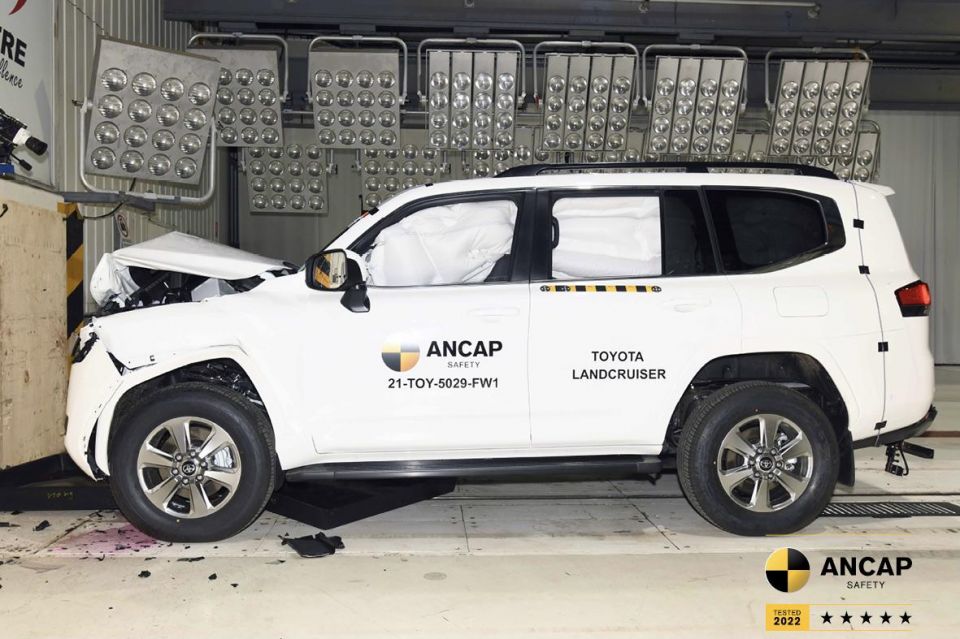
The Toyota LandCruiser 300 Series has recently been awarded a five-star ANCAP safety rating.
The burly beast napped 89 per cent for adult occupant protection and 88 per cent for child occupant protection – though the lack of child-seat points in the third row was noted – plus 77 per cent for safety assist driver aids.
Despite being so big and bluff, it also scored a good 81 per cent for vulnerable road user protection – the second-best score to date under the latest test protocols active since 2020.
The five-star safety rating applies to all variants of the Toyota LandCruiser – GX, GXL, VX, Sahara, and Sahara ZX – except the hardcore GR Sport which was not assessed.
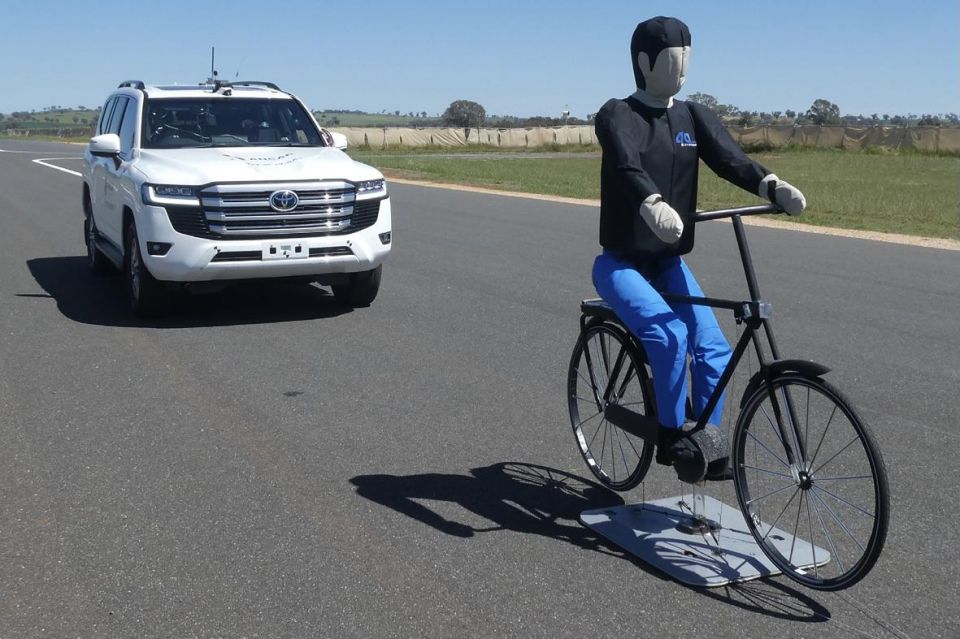
While the base GX misses out on blind-spot monitoring and rear cross-traffic alert – strange considering every RAV4 has these – the GXL includes them. The suite of safety features on offer also includes:
There’s a lane departure warning system with what Toyota calls “brake to steer”, which means it applies the brakes to keep you in your lane rather than applying steering torque as in most cars with a lane-keep assist feature.
There are 10 airbags, including curtain airbags that cover all three rows.

The 300 Series range may include luxury-focused models, but that doesn’t mean every variant has a luxurious interior. Case in point: the GXL, which has an interior about as nice as a RAV4 a third the cost.
If you’re looking at the GXL through the lens of a loyal LandCruiser owner who might be putting the SUV through its paces on the beaten track, then it’s not so bad.
Everything feels hard-wearing, the dark cloth-upholstered seats are comfortable and don’t seem especially susceptible to stains, and there’s still soft-touch trim with stitching details on the dashboard and door tops to improve the ambience.
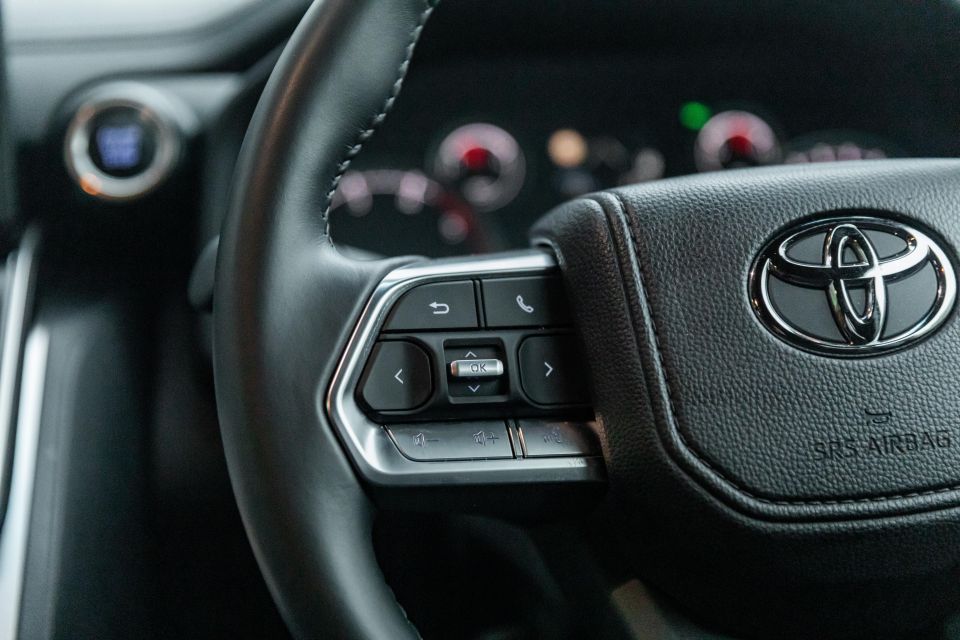
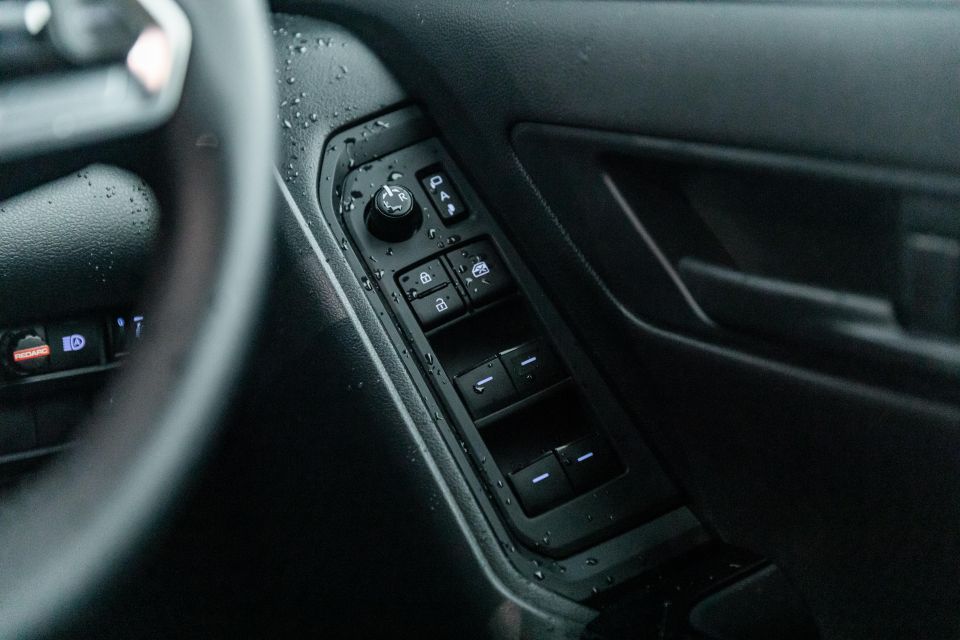
If, however, you’re comparing the GXL against other SUVs at this price point, it comes up short. The headliner is cheap, the plastic trim on the side of the centre console is hard and scratchy, and the plastic around the window switches and on the base of the steering wheel looks cheap.
Some of the cheapest parts of the interior include the plastic door handles and the flimsy sunglass holder, though nicer elements include the steering wheel controls.
The cabin is all rather funereal, with lots of black on black. A later ride in a Sahara ZX’s beige, leather-lined cabin was a revelation, but we know which interior we’d feel more comfortable tracking dirt into.
Among the many pieces of black trim are some piano black trim pieces, found on the doors and centre console. Given how easily this shows dust, smudges and scratches, it’s a poor choice for any vehicle’s interior.

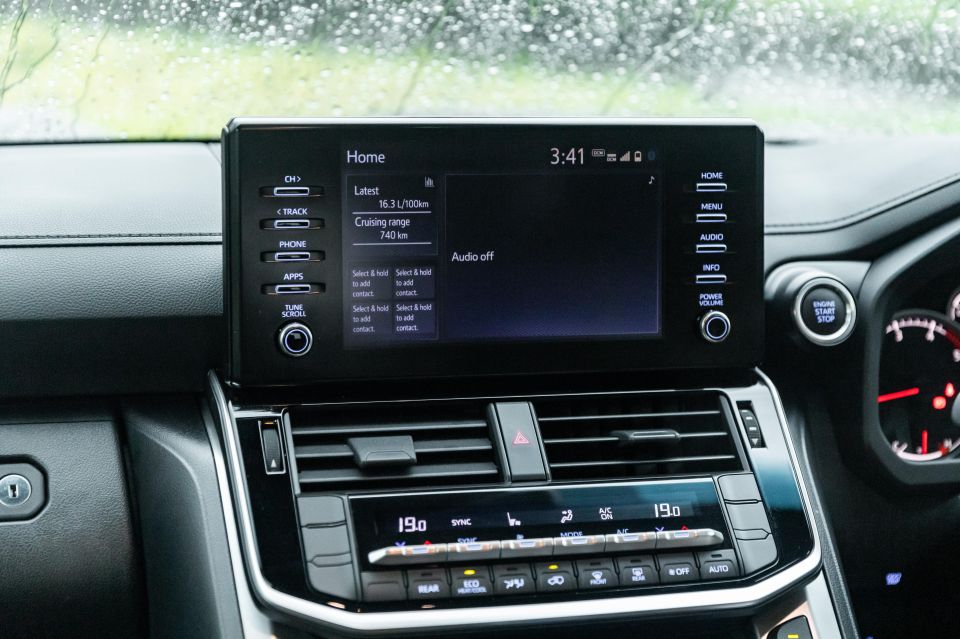
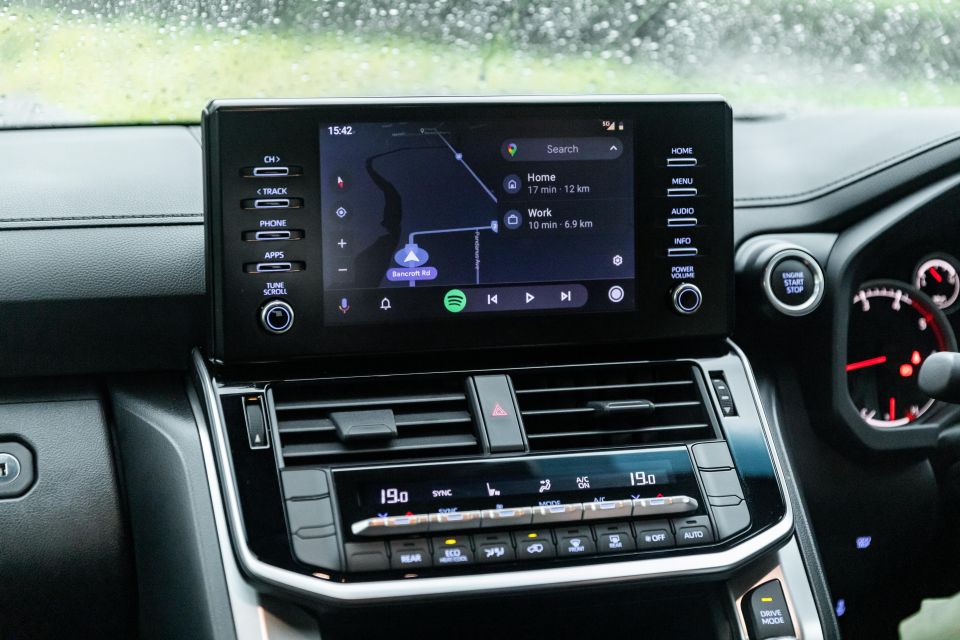
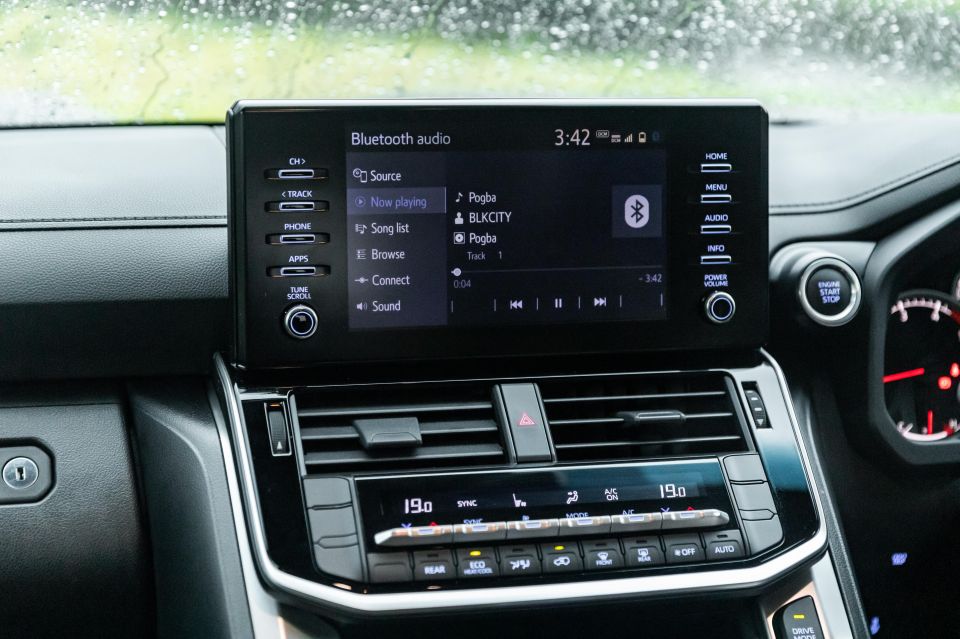
The infotainment system is essentially the same as you’ll find in a Corolla. Step up to higher-spec 300 Series models and many of our gripes with the cabin are largely resolved, except for the infotainment system. However, VX and up do at least get a larger, 12.3-inch screen.
Though Toyota is rolling out a new infotainment system, at least in overseas markets so far, the LandCruiser 300 Series was one of the last new vehicles from the brand to include the old system.
It looks dated, though it’s fairly easy to navigate and there’s smartphone mirroring on hand to banish the menus from view.
The analogue instruments and 4.2-inch screen in between are also familiar-looking, though we rate these more highly. They’re simple, neat and easy-to-read.
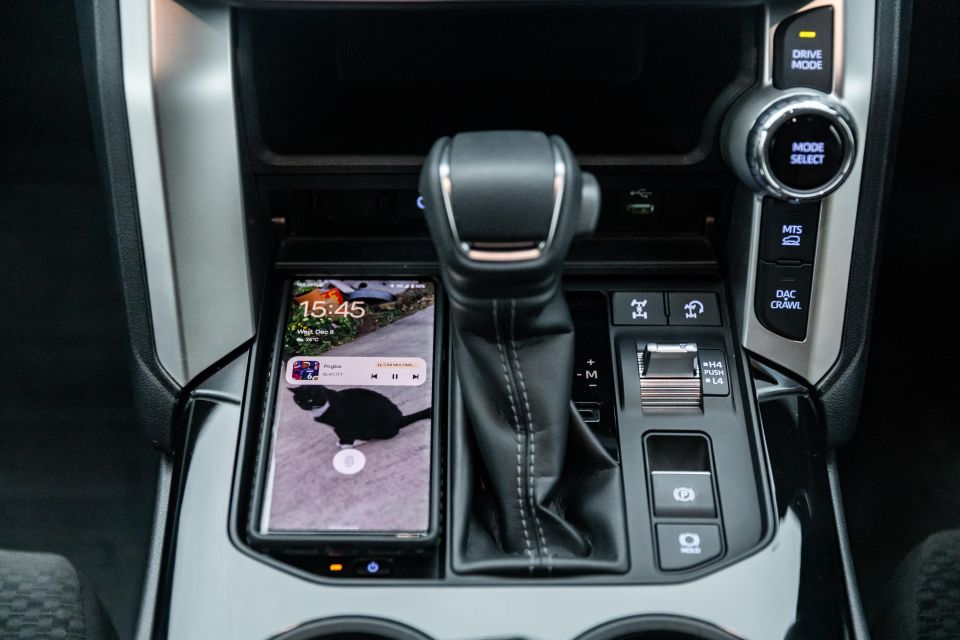
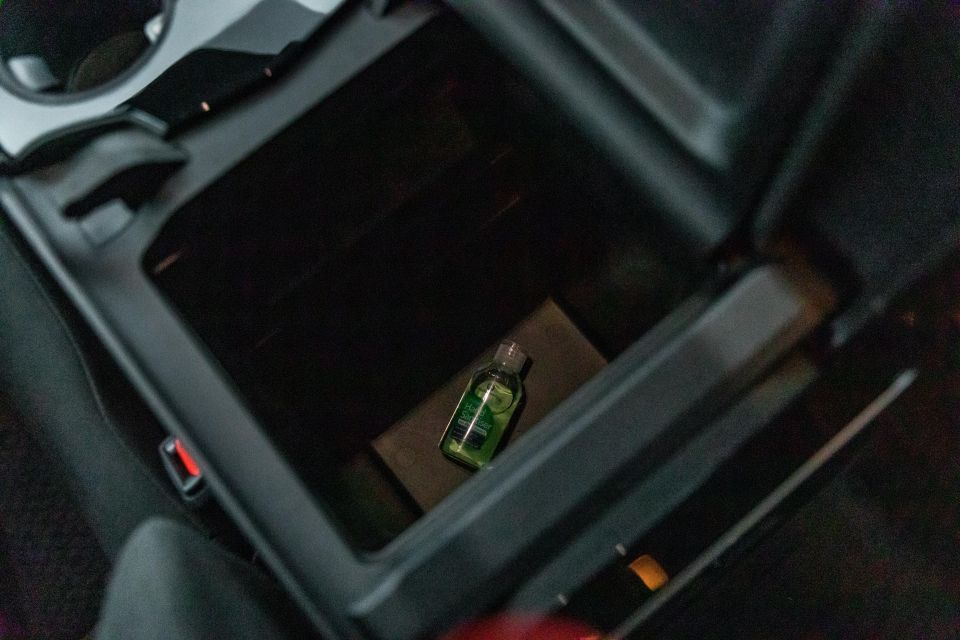
In terms of storage, there are bottle holders in each door big enough for some 1L bottles, plus a cavernous centre console bin with a one-piece lid, albeit one that can be opened from either side of the cabin. A pity the armrest on top isn’t particularly soft.
There’s a large wireless phone charger next to the shifter. It sits ahead of a row of charging outlets – one each of 12V, USB-A and USB-C – while above this is a shelf on the centre stack you can use for bits and bobs.
Second-row occupants can adjust the fan speed but not the temperature, and have access to a 12V outlet plus two USB-C outlets. There are, of course, air vents back here but surprisingly no fold-down centre armrest – again, that’s limited to VX and higher models.
There’s plenty of room in the second row in every dimension, though toe room could be better and there is a sizeable drivetrain hump to contend with. (Note: a sudden storm interrupted our photo shoot, hence the lack of a second-row shot)
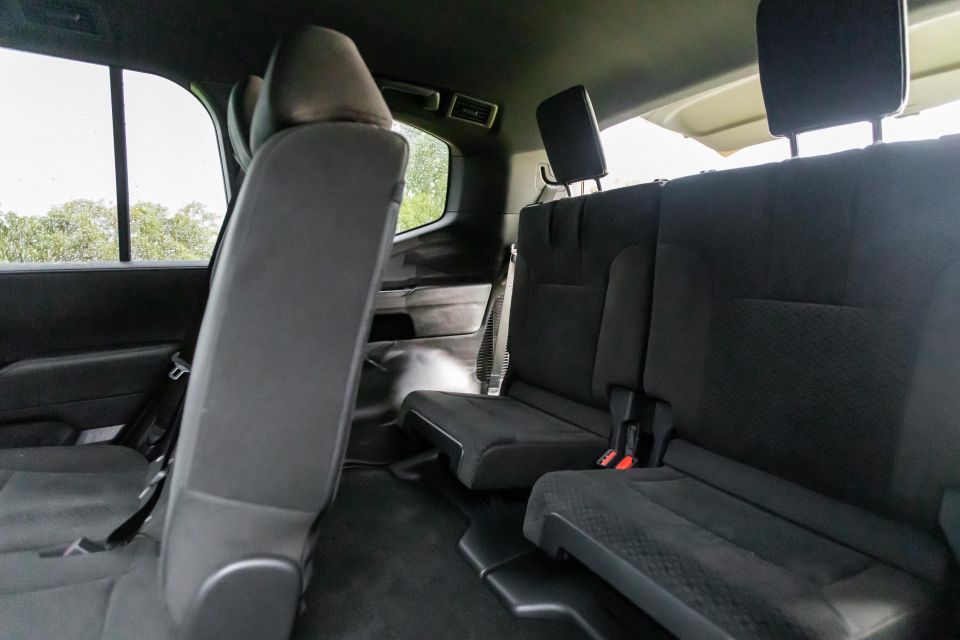

The third row is disappointing, particularly for an SUV this size, though we didn’t expect a huge improvement in space back here given the 300 Series is so dimensionally similar to its predecessor.
While the third row seats fold flat into the floor, they don’t pop up out of it with one simple tug of a strap or push of a button. Instead, you pull the seatback up and then pull the base out.
The base is quite short, too, making them look more like jump seats. They’re still suitable for children, but anybody larger will find a dearth of headroom and legroom. It’s also awkward clambering back here, though the second row lifts and folds up against the front row seatbacks with the pull of a single lever.
The second row doesn’t, however, slide back and forward, so you can’t free up additional room for third-row occupants.

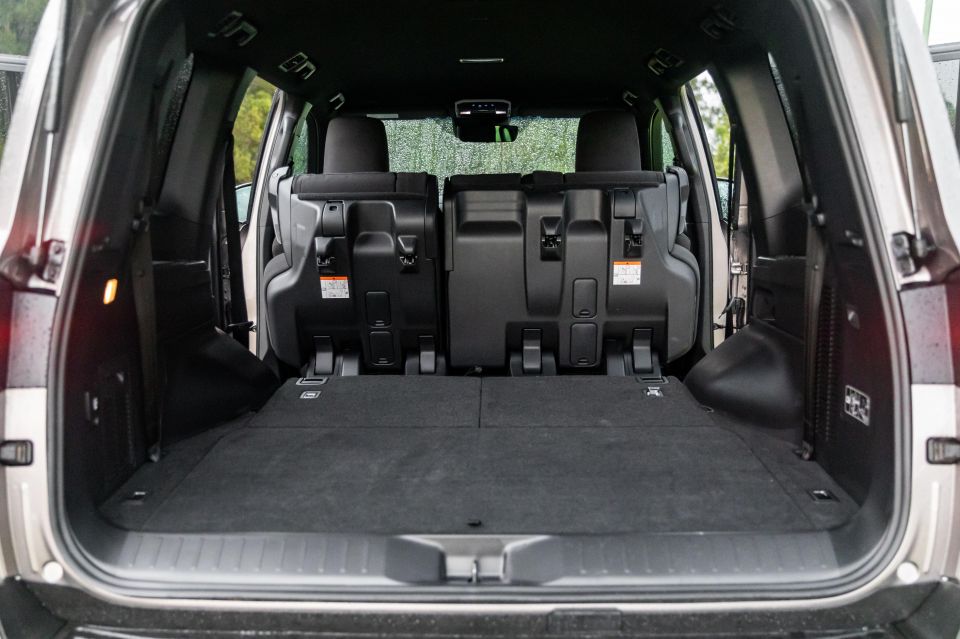

If you were expecting a third row as spacious as that of, say, a similarly-sized Hyundai Palisade, you’re going to be disappointed. The third row does, however, get one USB-C outlet and two cupholders on each side.
With all three rows up, you have 175L of cargo space – enough to fit a relatively small suitcase. Again, dealing with the third row is accomplished with two motions – pull a strap, then pull a handle – but it drops into the floor to create a flat load area with 1004L of space.
Dropping the second row yields 1967L of space all up, though these seats fold up against the front row seatbacks.
There’s a 220V outlet in the boot, while a full-size spare sits underneath the vehicle so as not to impinge on load space. Sadly, the split tailgate is gone.
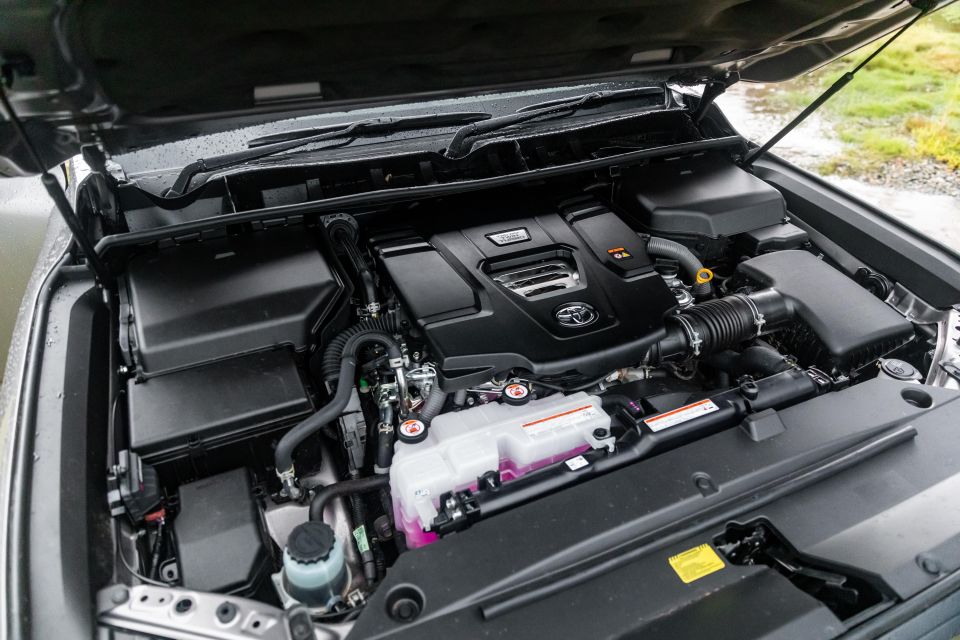
Where expert car reviews meet expert car buying – CarExpert gives you trusted advice, personalised service and real savings on your next new car.
The old 4.5-litre twin-turbo diesel V8 is gone, replaced with a new 3.3-litre twin-turbo diesel V6 with 27kW more power and 50Nm more torque. All up, the new mill produces 227kW of power at 4000rpm and 700Nm of torque between 1600 and 2600rpm.
It’s mated with a 10-speed automatic transmission and a full-time four-wheel drive system.
In a VX, the next rung up the model line-up, we recorded a 0-100km/h time of 8.2 seconds.
Braked towing capacity on all variants is 3500kg, while unbraked is 750kg. Gross vehicle mass is 3280kg and kerb weight is 2580kg – that’s 160kg less than the 200 Series GXL.
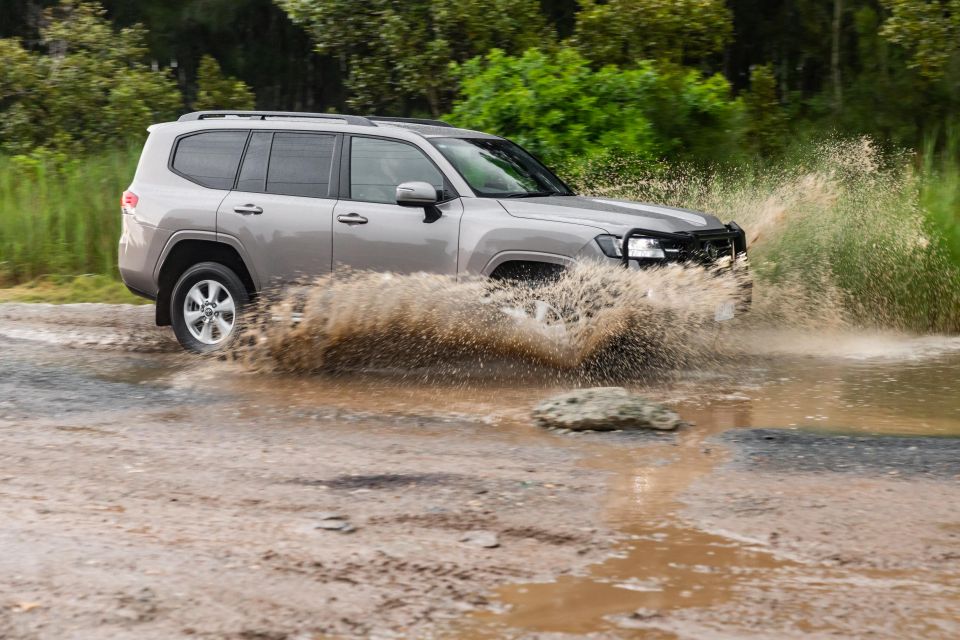
There’s a bit of diesel clatter on idle, and on the move the new V6 diesel isn’t the quietest mill. It sounds better than a Prado, though, if not quite as easy on the ears as the old V8 diesel.
It’s not just a case of all sound and no fury, with the twin-turbocharged diesel pulling effortlessly. Remember, this might be down two cylinders but it’s up in both power and torque, and this is evident when you get behind the wheel.
There’s virtually no turbo lag, either, which means power delivery is smooth and linear.
The 10-speed automatic transmission is mostly competent at shuffling between the gears but, like we experienced with the 10-speed in the Lexus LS, once in a while there’s a particularly abrupt shift that’s more of a shunt. It didn’t happen often, but we noticed it when we pushed the throttle and then let off a little bit.
If you want to manually shift your gears, you’ll have to use the shifter itself as there are no paddles behind the steering wheel.
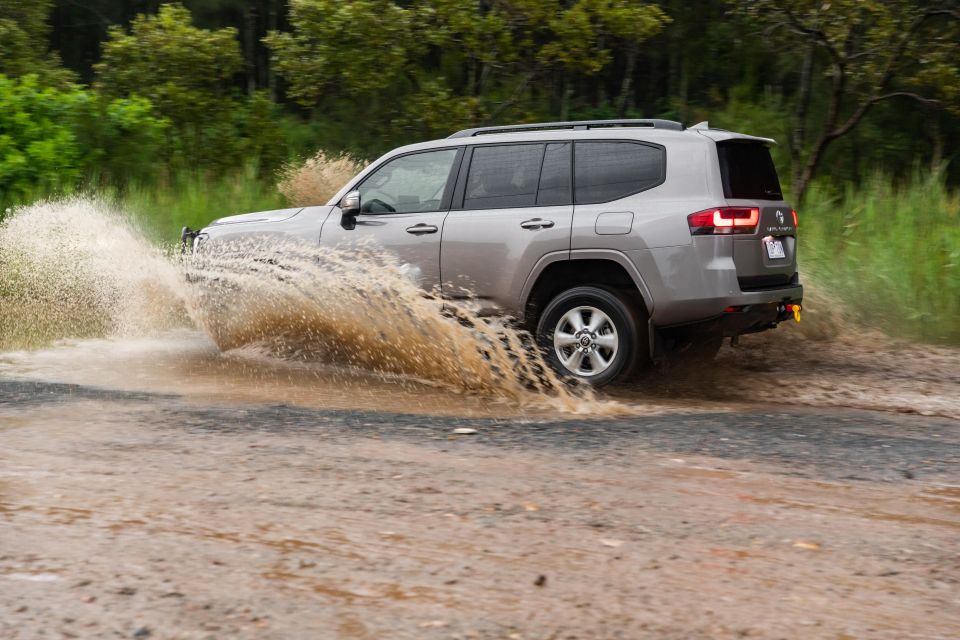
Around town, Toyota has managed to quell the flex and shuddering you can experience with body-on-frame construction, to the point where you’re approaching unibody levels of cohesion.
When you first go over a bump or rut, you only slightly experience that slightly loose feel typical of BOF vehicles, but everything’s been damped so nicely that the LandCruiser feels tighter, more refined and with superior body control than its construction would suggest.
It’s a little less composed on rutted rural roads, where it doesn’t feel quite as vault-like and has a busier ride.
Get onto a better-surfaced highway, however, and the LandCruiser impresses with its smooth, relaxed manner and solid feel. The cabin is also nicely hushed at high speeds, and the 300 Series hums along at 1500rpm, gobbling up the miles.
The steering is nicely-weighted, making this barge easy to turn. It doesn’t feel too numb, either, while the LandCruiser handles well for a large, body-on-frame SUV. It feels its size and weight and there’s the expected body roll in corners, but the handling is predictable and confidence-inspiring, if not as fluid as in a similarly-priced European unibody SUV.
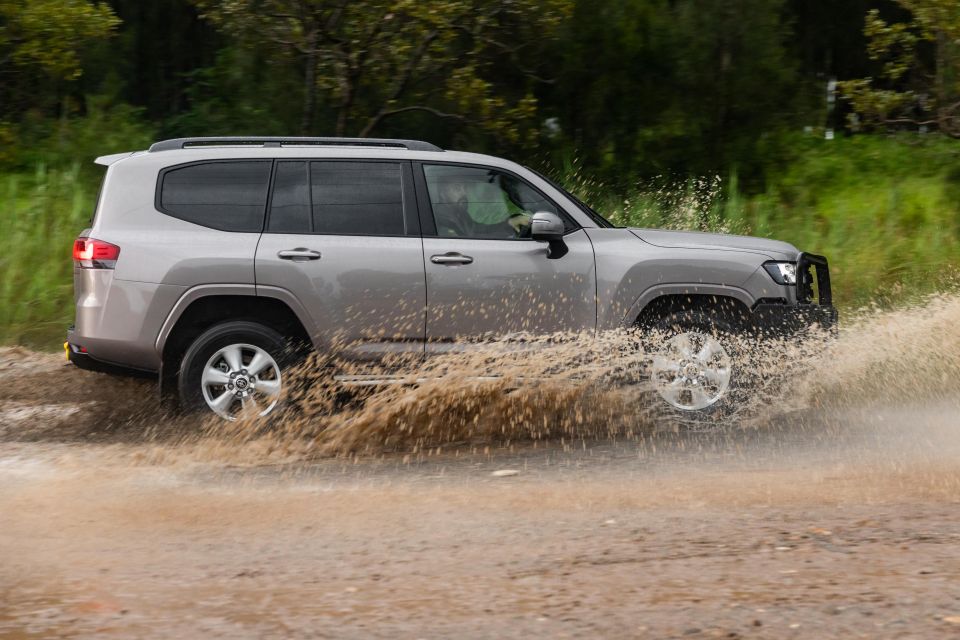
The brakes feel merely adequate at bringing this 2580kg beast to a halt. They’re not bad, but they could use a bit more bite.
If the obnoxiously loud lane departure warning chime doesn’t give you a fright, Toyota’s lane-keep assist system will. That’s because it intervenes using the brakes rather than the steering, as is more common with these systems, due to the 300 Series sticking with a hydraulically-assisted steering unit.
The system is abrupt and I eventually found myself turning it off every time I started the vehicle, which can be done with a long press of the steering wheel button.
Our off-roading was limited to some muddy tracks, which the LandCruiser breezed through with its full-time four-wheel drive.
It’s capable of tackling a lot more, with selectable low-range gearing, a crawl mode, and selectable terrain modes on hand, the latter adjustable via a nicely knurled rotary dial. A turn assist function also allows for tighter turns off the beaten track.
Locking front and rear differentials aren’t available in the GXL, though there’s a centre diff lock.
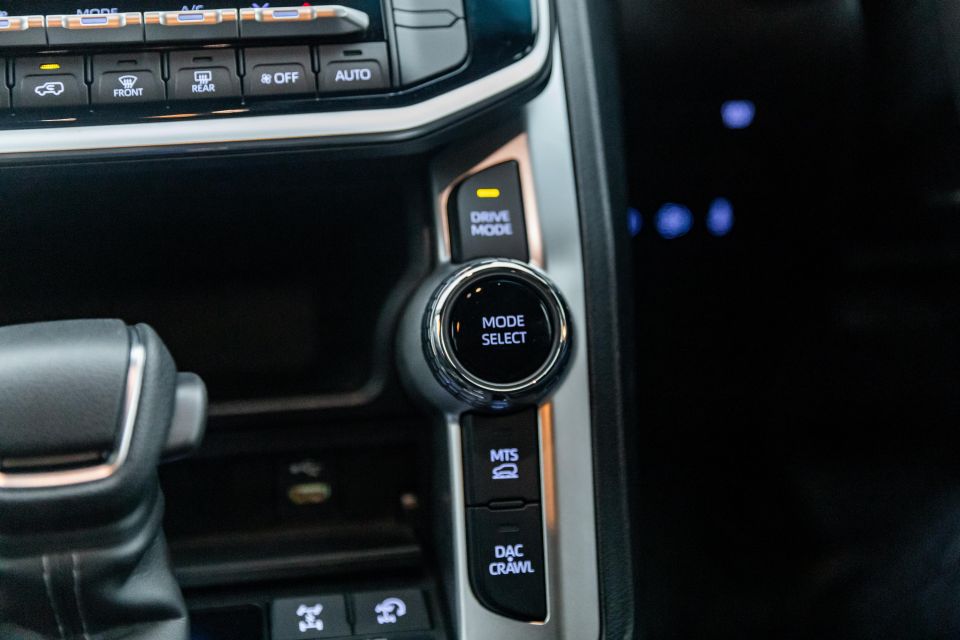
Ground clearance is 235mm, wading depth is 700mm, and the GXL has an approach angle of 32 degrees and a departure angle of 25 degrees.
To see how the 300 Series tackles the rough stuff, you can watch Paul Maric test the VX and GR Sport off-road on the CarExpert YouTube channel (VX video is at the top of the review).
It features largely the same off-road gear as the GXL, so it’s worth watching his video to see how the LandCruiser fares. Spoiler alert: Paul found its off-road equipment to be “idiot-proof” and the 300 Series tackled our off-road course with aplomb.
VX models and up get a four-camera multi-terrain monitor plus Toyota’s Vehicle Dynamics Integrated Management (VDIM), which the company says “links traction control, electronic stability control, electric steering and other systems to improve performance [and] responsiveness”.
The Sahara ZX and GR Sport gain adaptive suspension. The former also gets a rear torque-sensing limited-slip differential, while the latter receives locking front and rear diffs plus Toyota’s Electronic-Kinetic Dynamic Suspension System (E-KDSS). Up-spec LandCruiser models, therefore, aren’t just given nicer trim and extra convenience items to justify their higher prices.
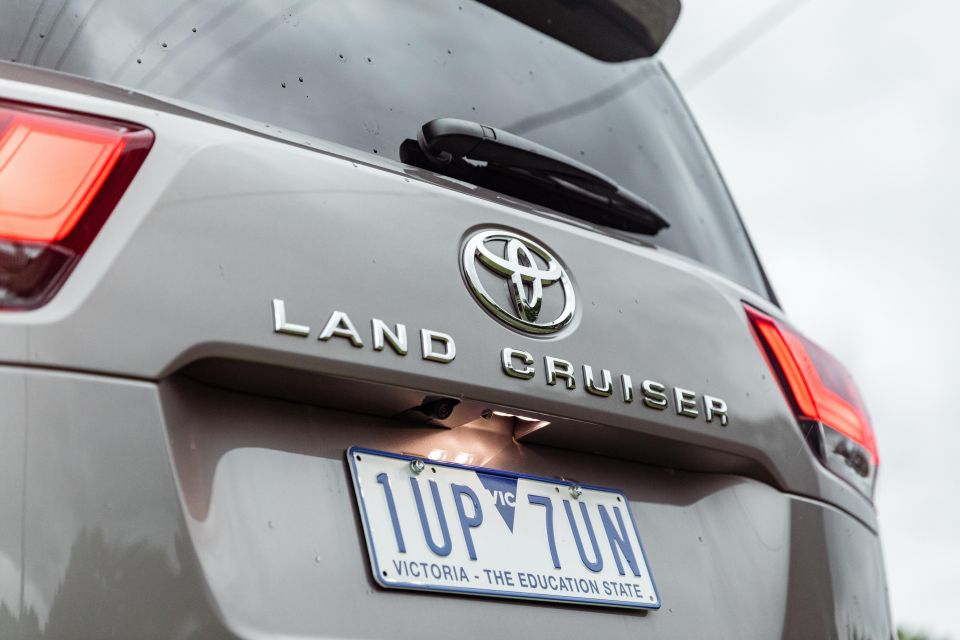
The LandCruiser is backed by a five-year, unlimited-kilometre warranty. Owners will be able to extend their warranty on the engine and driveline to seven years by sticking to the service schedule.
Toyota continues to insist on six-month, 10,000km servicing intervals, though at least it offers affordable service prices for an SUV of this size. Toyota Service Advantage covers capped-price servicing for the first 10 services at a cost of $375 each.
In contrast, a Nissan Patrol with identical servicing intervals costs anywhere between $376 and $860 for its first six services. Advantage: Toyota Service Advantage.
On our test loop, comprising a mix of inner-city, suburban and highway driving, we averaged 10.9L/100km. The official combined cycle rating is 8.9L/100km, compared with 9.5L/100km in the old 200 Series.
Fuel tank capacity is 110L, split across an 80L main tank and a 30L sub-tank.
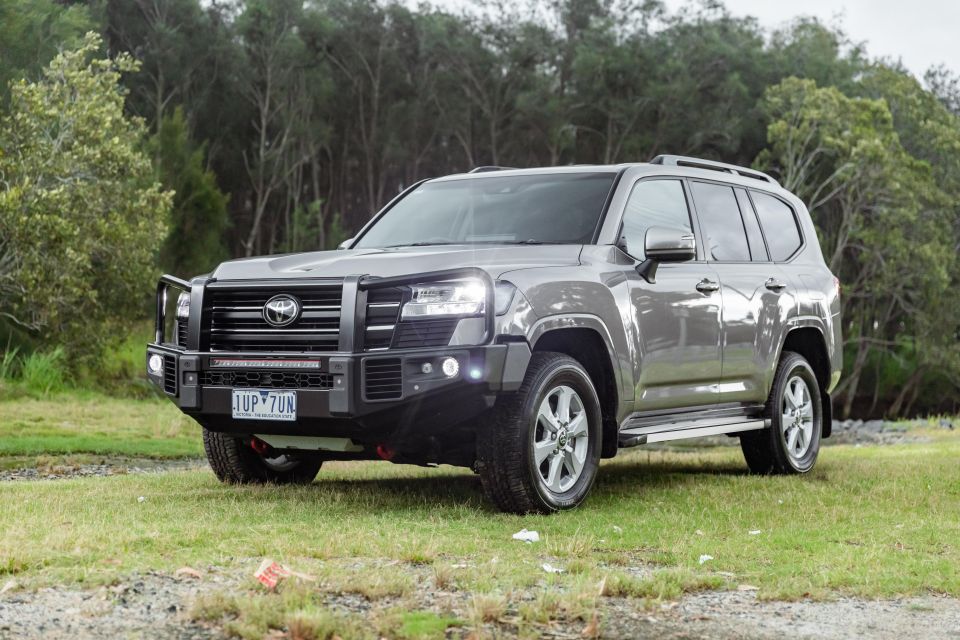
With the 300 Series, the LandCruiser continues to be a Swiss Army Knife of vehicles.
It’s quite comfortable on-road, capable off of it, and is a capable tower. If you don’t need this level of off-road or towing ability, there are SUVs at this price point that are either better-packaged, more comfortable on-road, or nicer inside, but none of them offer the peace of mind of Toyota’s expansive dealer network.
For loyal LandCruiser owners, there’s a lot to like about the 300 Series. It mightn’t have moved the game much in terms of infotainment, but the interior is more modern and the powertrain more powerful and more efficient.
For those more likely to cross-shop the LandCruiser with similarly-priced SUVs, its interior could be nicer and there are some frustrating feature omissions for a car north of $100,000. The older Nissan Patrol could appeal to more value-conscious buyers who still demand a LandCruiser-like level of off-road ability.
Nevertheless, with a responsive new turbo-diesel six, mostly refined road manners and, of course, the LandCruiser’s off-road credentials, Toyota has delivered an excellent new generation of one of its most iconic models.
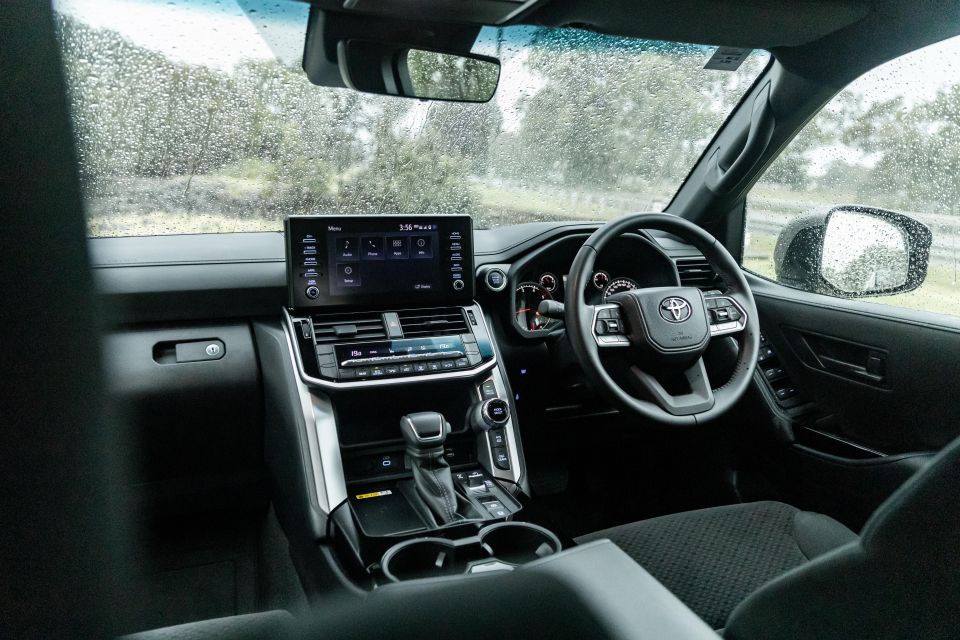
Click the images for the full gallery
Where expert car reviews meet expert car buying – CarExpert gives you trusted advice, personalised service and real savings on your next new car.
William Stopford is an automotive journalist with a passion for mainstream cars, automotive history and overseas auto markets.


Josh Nevett
2 Days Ago


CarExpert.com.au
3 Days Ago


Damion Smy
5 Days Ago


Derek Fung
5 Days Ago


Ben Zachariah
8 Days Ago
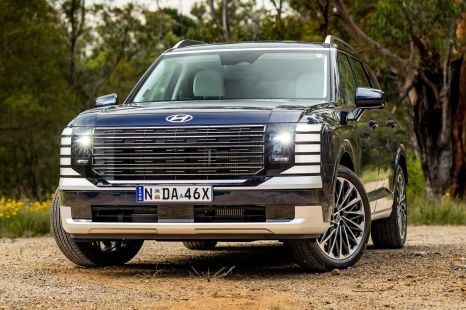

Matt Campbell
11 Days Ago